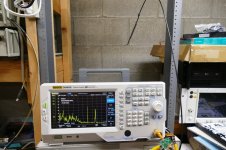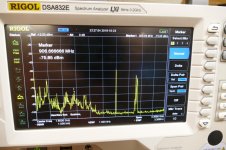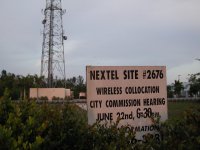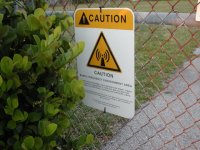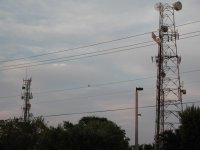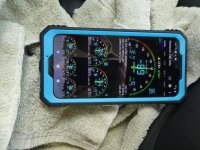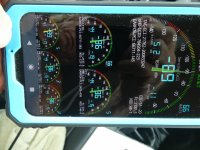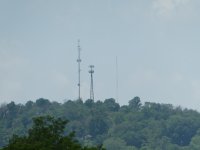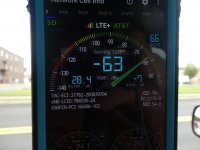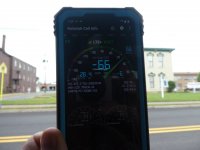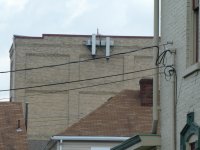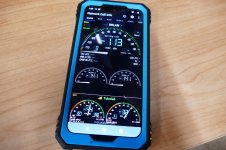George, I can see that as one future version coming within 1 - 2 centuries......let's turn off the biggest offenders....that would be the power grid, followed by all of the radio and TV broadcast services. All of the cell towers in a city don't add up to the RF power being pumped into air by the TV broadcast towers. The average cellular antenna on a tower runs at 20 watts. The average TV transmitter in the US runs at 500 KW with many at 1 MW.
@JN: Ty that makes perfect sense.
Corroborates with my experience on the "underling" side as well. We encourage everyone to participate, lab techs especially, as we do our job best when we help the boots on the ground guys! Both troubleshooting and accidental discoveries.
Formally, "what I think is happening is ..." seems okay as well, but with the care that it's a poorly understood topic you haven't explored yet and you're declaring that you're in hypothesis-making mode. The circles I frequent are doing a better and better job of saying "I don't know" when appropriate.
It's easy to sit back and talk....but a picture is worth...I don't know, with inflation, maybe 100 words.
I decided to do a 5 minute simple UNCONTROLLED, and therefore unscientific experiment. I performed similar experiments with far better equipment under more controlled conditions when I had Motorola's lab equipment and budget behind me.
Lesson learned....when you are standing in a field full of farm animals with a pile of test equipment on a cart powered by batteries and an inverter, be careful where you set your notebook. The goats will eat it and you will have to do all of the days testing over.
Here I simply fired up my spectrum analyzer, set it to sweep from 10 KHz to 3.2 GHz, and display the peak amplitude of every signal it finds in that frequency range over a 10 minute time period. In this mode a short burst for a few milliseconds will show at its highest value, as will a continuous signal. The continuous signals at lower amplitude will contain more total energy than short bursts at a higher level when both are averaged over time. Such a test can be done even with this analyzer, but it would take several hours. I an also in my basement lab, which is pretty well shielded from the weak signals outside the house. I have done this outdoors in my car, but I was concentrating on cell tower signals, and thus did not photograph any of the oddball RF stuff.
To extend the setup's dynamic range I put a cheap ($10 on Amazon) "30 db" RF amp in front of the analyzer. It does have 30 db of gain below 500 MHz, but it drops slowly to about 15 db of gain at 2 GHz and 5 db of gain at 3.2 GHz. The antenna I used is a flat plate designed for the US cellular bands. It's gain peaks at 800 MHz and at 1.8 GHz, with far less gain at other frequencies, but it was sitting on my workbench.
The test setup and screen picture are included.
The analyzer scans from 10 KHz to 3.2 GHz each division across the bottom of the screen is about 320 MHz.
The strongest signal on the display is at roughly 1.9 GHz. It is the random ping from my wife's iPHONE which is on a table about 20 feet from the antenna. It displays at -50 dbm on the analyzer, but the actual signal is probably about 10 - 20 db weaker due to amp and antenna gain.
The second strongest group of signals are the WiFi router, at 2.4 GHz. The router is about 10 feet from the antenna. My guess is that these signals are actually stronger than the phone pings, but the amp has little gain at this frequency and the antenna should be lossy at this frequency to avoid bluetooth interference.
Note the low frequency crud below about 1.2 GHz. ALL of this originates inside the house with one exception. The marker displays the signal from the smart meter. I have taken a portable spectrum analyzer to the meter to confirm the frequency.
Much of the low frequency stuff is leakage from the cable TV system. It goes away when I disconnect the cable from their distribution amp. Over a year ago I chased down some of the other unintentional radiators, and found that some of the TV sets radiate RF when they are turned OFF! The worst offender is an old Sony that was causing interference with ham radio reception on 146 MHz. There is a strong peak at 272 MHz. This is actually a bunch of single frequency signals scattered from 265 to 290 MHz and comes from the cable system. The antenna is I am using is not designed for these frequencies, but the RF amp has a lot of gain, so the actual signal level is unknown, but all of the crud averaged together over time could be the strongest offender here.
I am including some more pictures taken from the field where the "goats ate my homework." This was a 6 month exercise in chasing down interference caused by cellular systems to police radios. My final report on the matter ran 20 some pages and I had borrowed the title from a popular book / movie for obvious reasons......"The Two Towers." This particular location was the western most cell site in the area which borders on the Everglades swamp. The RF power for the west facing antennas was cranked up to the maximum to cover the 'glades. This was one of the worst interference related sites in the country at the time.
I decided to do a 5 minute simple UNCONTROLLED, and therefore unscientific experiment. I performed similar experiments with far better equipment under more controlled conditions when I had Motorola's lab equipment and budget behind me.
Lesson learned....when you are standing in a field full of farm animals with a pile of test equipment on a cart powered by batteries and an inverter, be careful where you set your notebook. The goats will eat it and you will have to do all of the days testing over.
Here I simply fired up my spectrum analyzer, set it to sweep from 10 KHz to 3.2 GHz, and display the peak amplitude of every signal it finds in that frequency range over a 10 minute time period. In this mode a short burst for a few milliseconds will show at its highest value, as will a continuous signal. The continuous signals at lower amplitude will contain more total energy than short bursts at a higher level when both are averaged over time. Such a test can be done even with this analyzer, but it would take several hours. I an also in my basement lab, which is pretty well shielded from the weak signals outside the house. I have done this outdoors in my car, but I was concentrating on cell tower signals, and thus did not photograph any of the oddball RF stuff.
To extend the setup's dynamic range I put a cheap ($10 on Amazon) "30 db" RF amp in front of the analyzer. It does have 30 db of gain below 500 MHz, but it drops slowly to about 15 db of gain at 2 GHz and 5 db of gain at 3.2 GHz. The antenna I used is a flat plate designed for the US cellular bands. It's gain peaks at 800 MHz and at 1.8 GHz, with far less gain at other frequencies, but it was sitting on my workbench.
The test setup and screen picture are included.
The analyzer scans from 10 KHz to 3.2 GHz each division across the bottom of the screen is about 320 MHz.
The strongest signal on the display is at roughly 1.9 GHz. It is the random ping from my wife's iPHONE which is on a table about 20 feet from the antenna. It displays at -50 dbm on the analyzer, but the actual signal is probably about 10 - 20 db weaker due to amp and antenna gain.
The second strongest group of signals are the WiFi router, at 2.4 GHz. The router is about 10 feet from the antenna. My guess is that these signals are actually stronger than the phone pings, but the amp has little gain at this frequency and the antenna should be lossy at this frequency to avoid bluetooth interference.
Note the low frequency crud below about 1.2 GHz. ALL of this originates inside the house with one exception. The marker displays the signal from the smart meter. I have taken a portable spectrum analyzer to the meter to confirm the frequency.
Much of the low frequency stuff is leakage from the cable TV system. It goes away when I disconnect the cable from their distribution amp. Over a year ago I chased down some of the other unintentional radiators, and found that some of the TV sets radiate RF when they are turned OFF! The worst offender is an old Sony that was causing interference with ham radio reception on 146 MHz. There is a strong peak at 272 MHz. This is actually a bunch of single frequency signals scattered from 265 to 290 MHz and comes from the cable system. The antenna is I am using is not designed for these frequencies, but the RF amp has a lot of gain, so the actual signal level is unknown, but all of the crud averaged together over time could be the strongest offender here.
I am including some more pictures taken from the field where the "goats ate my homework." This was a 6 month exercise in chasing down interference caused by cellular systems to police radios. My final report on the matter ran 20 some pages and I had borrowed the title from a popular book / movie for obvious reasons......"The Two Towers." This particular location was the western most cell site in the area which borders on the Everglades swamp. The RF power for the west facing antennas was cranked up to the maximum to cover the 'glades. This was one of the worst interference related sites in the country at the time.
Attachments
Hey. Many kind Thanks for your very detailed analysis of the various sources of EM smog that is already out there. Gives some perspective. Valuable read for those who are not in the know.Triangulation isn't needed or used to find you. All modern phones have sat nav (GPS, Glonass...) systems built in. These can be activated remotely by the emergency management people (911) in your country, and probably many more.
People fear being zapped by satellites in the sky, yet walk around with a bluetooth transmitter stuck in their ear, and live with a constant 50 / 60 Hz EM field around them. The power grid runs in the gigawatt power level and some parts of it are very close to us. A bluetooth device runs at the milliwatt power level, but may be inches from the brain.
A LEO satellite in the sky is at least 100 miles away and has a very finite and small power system. We are already being zapped by GPS and other sat nav signals from space, but it takes some very specialized and sensitive equipment to even detect them. The signals are actually below the noise floor and require DSP magic to recover them.
Geosynchronous satellites are by definition about 22,000 miles away. They are larger and more powerful, but the distance makes their signals weaker.
The average human in an urban environment probably receives far more EM radiation from the nearby EM generators, yet we chose to fear stuff that's miles away.
Stick an antenna on an RF spectrum analyzer and take it for a ride. I did this for years in my job at Motorola, usually while chasing down interference between different types of wireless service, often police and cellular, or TV and UHF two way radio. The worst RF environment I found in several years of doing this was at the upper level of the NFL football stadium in Miami Florida. Here you are up in the air and right next to the antenna farm for all of the Miami TV stations. Each TV transmitter has an Effective Radiated Power level from 500 KW to 1 MW, and there were 10 of them at that time. That location became one of our RF torture tests for new UHF radio equipment designs. I had other RF hot spots on the map for each unique combination of radio frequency bands we used.
I have also done it here in rural nowhere while trying to find a cellular signal strong enough to boost and bring into the house. There are far less RF signals here and all of them combined add up to less energy than the WiFi hotspot in the basement.
Other than the power grid, the biggies are the broadcast services, TV, AM and FM radio. In a densely populated area you may find a blanket of constant radio, TV and low level microwave (door openers at 10 GHz) and transient signals from the RF devices we use daily, and yes cell phones are quite strong when close by, but transient since the user is typically moving. Some of the newer cars emit radar in the 33 GHz region as part of the collision avoidance system, and this can be quite strong. Again, a transient signal that is largely reflected by the car you are in.
Standing under a cell or TV tower, you will find weak or no signals, since the waves radiate out perpendicular to the antennas up on the tower. The signal strength on the ground peaks at 1/4 to 5 miles away depending on the height of the tower, and the down tilt of the antennas. I have seen places where there is a cellular antenna on a tower near a tall building such that it is almost outside a window. This WILL provide a strong signal at that window.
This brings me to another "Fear Factor," smart meters. People fear these as much as 5G. There is a smart meter on the side of my house with only wood and plastic between me and it. The RF spectrum analyzer on my workbench is about 10 feet from the meter. The meter emits a random burst of RF energy in the 900 MHz region when it wants to. Sometimes it's every few seconds, usually it can go for minutes or hours without sending anything. Its RF signal strength is weaker than the Comcast WiFi box which transmits constantly, and far weaker than a cell phone at the same distance, and transmits far less often. A modern 4G cell phone will ping the tower every minute or so even when it's just sitting on a table unused, but powered on.
Everyone on the planet does get a constant dose of EM energy. For those living in remote areas without a power grid, it's quite low, undetectable without special equipment.
For those working in a modern office building the total EM exposure would be a hodge podge of transient signals like cell phones, and constant emissions of EM from WiFi, power delivery, and all the stuff we don't even think about like the SMPS's inside every "energy efficient" LED light bulb. I have to turn off the lights in my basement to get an accurate THD reading on my HP 8903A audio analyzer due to interference from the switchers in the LED lighting, and even with the lights off the analyzer reads a background level of about 0.4 millivolts at 60Hz.
OK, we ARE all part of some giant EM experiment.....let's turn off the biggest offenders....that would be the power grid, followed by all of the radio and TV broadcast services. All of the cell towers in a city don't add up to the RF power being pumped into air by the TV broadcast towers. The average cellular antenna on a tower runs at 20 watts. The average TV transmitter in the US runs at 500 KW with many at 1 MW.
{Personally, I did my fare share of driving around and chasing/measuring signal levels, while implementing a pilot Mototrola Wireless Local Loop CDMA system, in the vicinity of Warsaw, Poland. But that was many years ago. }
Thought I'd elaborate a tad on these two links.
The first, the title is a not so subtle diss on science...
Study: half of the studies you read about in the news are wrong - Vox
If one actually reads the article, it's not half bad. They even self depricate in the second sentence, giving a good tenor on the overall.
However, the proper inferences have not been made.
First, I like how wine leans towards the good side...I'm more than happy to ignore the studies that said it was bad...😀
Tomatoes, eh...
What the graphical data they provided shows is quite simple. It appears to be a somewhat gaussian distribution around neutral. (except for the good wine). That tells me that the metric is incapable of finding a result that is outside of the noise of the data. Some show up, some show down..stats, sample size, that kind of stuff.
To simply state that a study that leaned on one side is the cat's meow, that is cherry picking. With enough studies and a centered gaussian distribution, it is simple to pick only the studies on one side or the other to "prove" ones' point. That is my issue with these crackpot websites being pointed to.
This is a little more interesting..
http://primarywater.org/
From the verbage, some of it is written as if the earth is "creating" the water. Weird prose if you ask me.
In looking through some of the history, it seems that many of the claims on well output were drastically overstated. In addition, apparently much of the water was very heavy in mineral content..I believe "brackish" is the term.
So, as a huge source of water, it seems that well has shall we say, gone dry?
It is soooo easy to post these links from the cheap seats, never actually doing any research but instead being spoon fed by others with agenda's. That is why I always recommend intellectual vigil, always look beyond the glitzy headlines, critically inspect what appears to be either fantasy or falsehood.
jn
The first, the title is a not so subtle diss on science...
Study: half of the studies you read about in the news are wrong - Vox
If one actually reads the article, it's not half bad. They even self depricate in the second sentence, giving a good tenor on the overall.
However, the proper inferences have not been made.
First, I like how wine leans towards the good side...I'm more than happy to ignore the studies that said it was bad...😀
Tomatoes, eh...
What the graphical data they provided shows is quite simple. It appears to be a somewhat gaussian distribution around neutral. (except for the good wine). That tells me that the metric is incapable of finding a result that is outside of the noise of the data. Some show up, some show down..stats, sample size, that kind of stuff.
To simply state that a study that leaned on one side is the cat's meow, that is cherry picking. With enough studies and a centered gaussian distribution, it is simple to pick only the studies on one side or the other to "prove" ones' point. That is my issue with these crackpot websites being pointed to.
This is a little more interesting..
http://primarywater.org/
From the verbage, some of it is written as if the earth is "creating" the water. Weird prose if you ask me.
In looking through some of the history, it seems that many of the claims on well output were drastically overstated. In addition, apparently much of the water was very heavy in mineral content..I believe "brackish" is the term.
So, as a huge source of water, it seems that well has shall we say, gone dry?
It is soooo easy to post these links from the cheap seats, never actually doing any research but instead being spoon fed by others with agenda's. That is why I always recommend intellectual vigil, always look beyond the glitzy headlines, critically inspect what appears to be either fantasy or falsehood.
jn
Here is a little more info for those who want to do some simple testing yourself.
Every cell phone back to 2G takes constant signal strength measurements on the cell it is receiving from, AND on several "neighbor cell" which the phone could possibly hand over the call to. Most phones / networks use different cells and frequency bands for phone calls VS data traffic.
You can get an app for your phone that will display this data. I use an app called Network Cell Info which will display the data for phone calls when you are actually in a call, and data traffic when not in a call. Like any app it can only display the data for the network you are actually authorized to use. My phone is on AT&T so it will show me all the AT&T signals that my phone is currently receiving. The spectrum analyzer has told me that AT&T uses band 30 at 2.3 GHz, but my cheap phone does not cover this band so it will not be displayed.
It will measure the signal strength. This is the power delivered from the tower to the phone, and therefore into the human holding the phone. This is displayed on a "speedometer" type scale and updates quickly ar you move through cell coverage, making it easy to find the towers. I have used this to find the two cell sites that serve my rural area. They are cranked up to somewhere near maximum power to serve the hilly country side surrounding the town. The tower site does not reach my house about 2 miles away due to severe blockage. The site on the building does barely on dry days, and in winter when the trees are bare. During the summer, I get no usable signal.
It is measured in dbm which is a log scale exactly the same as audio power. 0 dbm is a strong RF signal at 1 milliwatt of power. Each 10 dbm represents a factor of 10 in power, so that -10 dbm is 100 microwatts, -20 dmb is 10 microwatts, -30dbm is 1 microwatt, -60 dbm is 1 nanowatt, -90 dbm is 1 pico watt, and -120 dbm is 1 femtowatt.
Note that the scale starts (upper limit) at -45 dbm, thus the maximum expected signal from a tower will be less than 60 NANOWATTS.
I have found an AT&T cell site in town. It uses some flat plate antennas mounted on the side of a building approximately 60 feet above the street below. They can be seen in the picture. I drove and walked around the area until I found the strongest signal on the ground. The signal in my car was slightly stronger than the same spot walking. The strongest signal seen from the city site was -63 dbm or 2 NANOWATTS of RF power.
There is a tower on a hill about 300 feet above the city and 400 feet above the OHIO river. I drove nearly every passable road surrounding that tower measuring it's many signals with the spectrum analyzer and phone app. The strongest on ground signal was in the -84 dbm range, about 5 picowatts.
The same app can measure the signal strength of the WiFi signal that your phone receives. This photo shows that there are two WiFi signals here at my computer. The weaker one is the 5.7 GHz WiFi signal at -44 dbm and the
stronger is the 2.46 GHz WiFi signal at -32 dbm (about two microwatts). These signals are about 1000 times stronger than any cellular signal I can find on the ground today.
It has been stated that the signals from the tower to the user for 5G will be on par with, or weaker than the current 4G signals. 5G will operate in spectrum from 4 to 8 GHz. Why should I worry about some future signals which should be 1000 times weaker than what's in my house NOW!
Every cell phone back to 2G takes constant signal strength measurements on the cell it is receiving from, AND on several "neighbor cell" which the phone could possibly hand over the call to. Most phones / networks use different cells and frequency bands for phone calls VS data traffic.
You can get an app for your phone that will display this data. I use an app called Network Cell Info which will display the data for phone calls when you are actually in a call, and data traffic when not in a call. Like any app it can only display the data for the network you are actually authorized to use. My phone is on AT&T so it will show me all the AT&T signals that my phone is currently receiving. The spectrum analyzer has told me that AT&T uses band 30 at 2.3 GHz, but my cheap phone does not cover this band so it will not be displayed.
It will measure the signal strength. This is the power delivered from the tower to the phone, and therefore into the human holding the phone. This is displayed on a "speedometer" type scale and updates quickly ar you move through cell coverage, making it easy to find the towers. I have used this to find the two cell sites that serve my rural area. They are cranked up to somewhere near maximum power to serve the hilly country side surrounding the town. The tower site does not reach my house about 2 miles away due to severe blockage. The site on the building does barely on dry days, and in winter when the trees are bare. During the summer, I get no usable signal.
It is measured in dbm which is a log scale exactly the same as audio power. 0 dbm is a strong RF signal at 1 milliwatt of power. Each 10 dbm represents a factor of 10 in power, so that -10 dbm is 100 microwatts, -20 dmb is 10 microwatts, -30dbm is 1 microwatt, -60 dbm is 1 nanowatt, -90 dbm is 1 pico watt, and -120 dbm is 1 femtowatt.
Note that the scale starts (upper limit) at -45 dbm, thus the maximum expected signal from a tower will be less than 60 NANOWATTS.
I have found an AT&T cell site in town. It uses some flat plate antennas mounted on the side of a building approximately 60 feet above the street below. They can be seen in the picture. I drove and walked around the area until I found the strongest signal on the ground. The signal in my car was slightly stronger than the same spot walking. The strongest signal seen from the city site was -63 dbm or 2 NANOWATTS of RF power.
There is a tower on a hill about 300 feet above the city and 400 feet above the OHIO river. I drove nearly every passable road surrounding that tower measuring it's many signals with the spectrum analyzer and phone app. The strongest on ground signal was in the -84 dbm range, about 5 picowatts.
The same app can measure the signal strength of the WiFi signal that your phone receives. This photo shows that there are two WiFi signals here at my computer. The weaker one is the 5.7 GHz WiFi signal at -44 dbm and the
stronger is the 2.46 GHz WiFi signal at -32 dbm (about two microwatts). These signals are about 1000 times stronger than any cellular signal I can find on the ground today.
It has been stated that the signals from the tower to the user for 5G will be on par with, or weaker than the current 4G signals. 5G will operate in spectrum from 4 to 8 GHz. Why should I worry about some future signals which should be 1000 times weaker than what's in my house NOW!
Attachments
A THOUSAND times less for 5G than 4G?
NO, 4G and 5G will likely be at about equal levels, though 5G could be potentially lower due to the smaller cell size.
What I did say is that real measurements on current 4G cell towers show them to about 1000 times weaker than the WiFi hotspot we have in our houses today, when measured at the users location. This is because the WiFi router is much closer, and with RF or any EM field, distance is your friend.
NO, 4G and 5G will likely be at about equal levels, though 5G could be potentially lower due to the smaller cell size.
What I did say is that real measurements on current 4G cell towers show them to about 1000 times weaker than the WiFi hotspot we have in our houses today, when measured at the users location. This is because the WiFi router is much closer, and with RF or any EM field, distance is your friend.
Ah, sorry. Thanks for straightening me out. Any numbers over ten I really should take my shoes off. Course that only gets me to 20.😕
Jn
 Off Topic rubbish and bickering posts deleted. Keep it within the rules, gentlemen, or this thread will be closed.
Off Topic rubbish and bickering posts deleted. Keep it within the rules, gentlemen, or this thread will be closed.At the end of the day wifi routers are probably the evilest thing out there for RF glorp, although anyone who is a licenced ham has a special hatred for powerline repeaters as they turn the household wiring into an antenna and in general the regulators will do nothing if they are horribly out of spec. Neither of these care about power control. Cellular systems are all about power control and getting the signal across at the lowest power level possible. The reason for this is that most networks are interference limited in built up areas. As cells get smaller they start to interfere with each other and agressive power control is one of the main ways of reducing this. A key reason behind the MIMO developments in 4G was NOT to burn out your eyeballs, but to reduce interference.
So signal levels, even when using the phone will be carefully controlled in real time to give you just as much as you need.
I have also yet to see a credible analysis of how all this data is going to be backhauled. Lots of utopian arm waving but to me some things still don't stack up.
So signal levels, even when using the phone will be carefully controlled in real time to give you just as much as you need.
I have also yet to see a credible analysis of how all this data is going to be backhauled. Lots of utopian arm waving but to me some things still don't stack up.
I was surprised to find such a strong signal coming from it. Mine is one provided by the cable TV company. They swapped it out about a year ago, about the same time that they started offering cell phone service over WiFi.wifi routers are probably the evilest thing out there for RF glorp
anyone who is a licenced ham has a special hatred for powerline repeaters
There are lots of things that hams such as myself have learned to dislike. A chunk of the 220 MHz band was taken and given to UPS for package tracking. It is quasi legal for people to operate an unlicensed WiFi like internet service in the US in the 902-928 MHz ISM/ham band, with up to 50 WATTS of power. There are several here who are operating a subscription (paid) ISP service in this band making it useless for hams. As I stated earlier, I found that a good chunk of the 2304 MHz ham band is now AT&T's band 30. I hear that there is a proposal for some other private entity to take a chunk of 2 meters. The list goes on.
how all this data is going to be backhauled.
Therein lies the real problem and the need for GHz of bandwidth at the millimeter wave frequencies.
Read all the hype about the IoT. Some claim billions of devices will be operable within a few years. Back in the 1990's I was working in a "skunkworks" facility at Motorola during the decline of paging as cell phones became available. The concept was, "the paging market is saturated. If we can't put more pagers on people, lets put pagers in things." We designed and built signs, billboards, golf course lighting and irrigation systems, and other neat "connected things," but the concept never took off and that division closed down. Now, I hear the same mantra....lets put cellular in things.
So signal levels, even when using the phone will be carefully controlled in real time to give you just as much as you need.
Many of the multicarrier systems in use today, especially if CDMA based require accurate power control in the phone's transmitter. The usual cell site receiver will digitize a block of signal from several phones at once at the IF frequency with a 14 or 16 bit A/D converter, then sort it all out in the DSP. One rogue phone transmitting at full power can suck up a lot of the converters dynamic range making the weaker signals unrecoverable.
I've spent a good chunk of the last decade working on some systems that are now considered 'IoT'. Most of these are really good old fashioned SCADA type applications so really just deploying 50 year old concepts to the cloud with added data slurpage. I don't see where the billions of devices are coming from but I'm usually wrong when I say that no one would be daft enough to buy 'xyz'.
I don't see where the billions of devices are coming from
I don't either but the marketing department at AT&T would like us to believe....
IoT Solutions & Platform as a Service at AT&T Business.
Most of these are really good old fashioned SCADA type applications
I have been doing some contract work on a "thing" that will move a good bunch of data from a potentially moving source through the cellular network and into the "cloud."
Much of the work I did at Mot in the 90's was for small scale SCADA systems. I used a hacked two way walkie talkie board for two way data comm at 9600 baud. We had to be careful at marketing these things as to not compete with Motorola's high profit microwave SCADA group. Later I went on to design a pair of UHF transceiver boards to replace the hacked radio chassis. These were used for years, mostly in wireless bar code scanners and inventory control systems.
A number of new cars these days leave the factory with 3 Sims installed for different purposes. Current Jag models have 23 antennas!
The stuff they do at work produces unimaginable amounts of data. Terabytes that have to stored for later data mining. Where they store petabytes and how they do it is incomprehensible to me. Hundreds of fibers to prevent bottlenecks, I at least know what a fiber is.
I recognize none of the applications, nor the systems they use. In the seminars, lectures, and town halls where they describe it, all I can do is drool out the side of my mouth, trying to stay awake, and keep the look of utter incomprehension off my face.
While I believe I have been successful at hiding my ignorance, I suspect the drool gives me away.
Jn
I recognize none of the applications, nor the systems they use. In the seminars, lectures, and town halls where they describe it, all I can do is drool out the side of my mouth, trying to stay awake, and keep the look of utter incomprehension off my face.
While I believe I have been successful at hiding my ignorance, I suspect the drool gives me away.
Jn
Current Jag models have 23 antennas!
And we worry about cell towers that are miles away.
When my wife was looking to replace her "cheap Jeep" which was originally purchased because it was the cheapest new vehicle available in the entire county, we went to the local Subaru store. They had several vehicles that we were considering, but not ONE car on the lot that didn't talk to you and expect you to talk to it. I don't use Siri, Cortana, or Google Assistant, and I certainly don't want such an annoying distraction in my car......I guess I am really turning to an old fart.
You are not alone. I am a decade(ish) behind you and have no wish for a modern car. I like to drive and prefer old fashioned mostly clockwork cars that do what I tell them to do.
You are not alone. I am a decade(ish) behind you and have no wish for a modern car. I like to drive and prefer old fashioned mostly clockwork cars that do what I tell them to do.
I wouldn't mind getting the old air cooled horizontal 40 horse 4 banger back.
Life was just so much simpler. Or even the suzy 550 4 stroke..
Both of which were horrible options in the winter. I suspect they never ever made a VW bug that had adequate cabin heat.
jn
>I suspect they never ever made a VW bug that had adequate cabin heat.
While I was looking out a 4" x 4" ice-hole in the lower left corner of the windshield to drive, I certainly did enjoy both-wheel traction and that engine essentially sitting over the rear wheels during snowy conditions. My first car -
I signed the petition to try and block 5G deployment. I really dont care about the IoT, as I think most of it is pure rubbish. I think there's been at least two *decades* within which they've tried to sell us on that one - no one wants it.
Just what I need - another subscription service name / password to tell me how often my sump pump turned on last month, or other "crucial" info. Whoop-de-do.
While I was looking out a 4" x 4" ice-hole in the lower left corner of the windshield to drive, I certainly did enjoy both-wheel traction and that engine essentially sitting over the rear wheels during snowy conditions. My first car -
I signed the petition to try and block 5G deployment. I really dont care about the IoT, as I think most of it is pure rubbish. I think there's been at least two *decades* within which they've tried to sell us on that one - no one wants it.
Just what I need - another subscription service name / password to tell me how often my sump pump turned on last month, or other "crucial" info. Whoop-de-do.
- Home
- General Interest
- Everything Else
- Extinction Level Event: 5G. Death by the trillions
